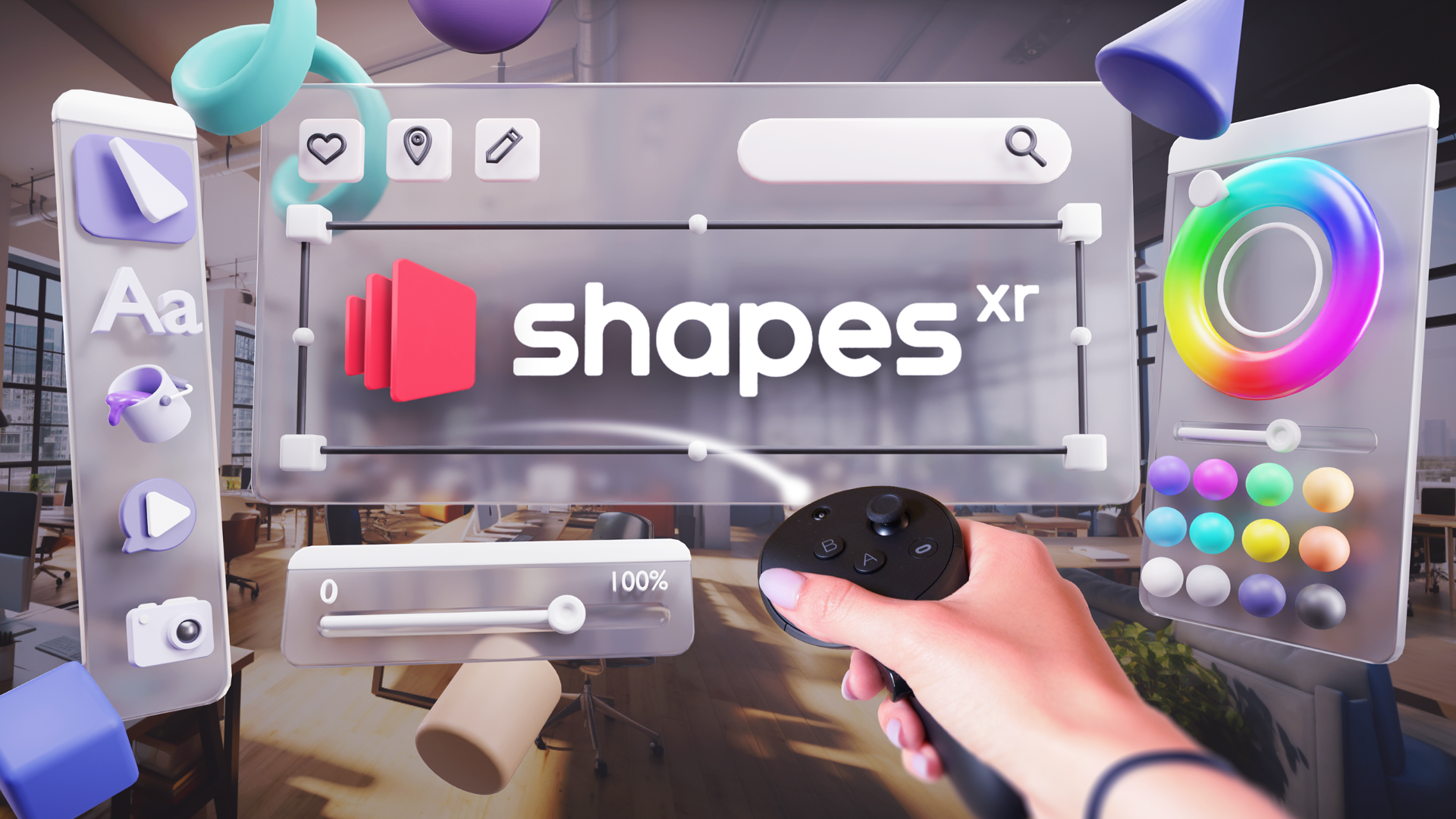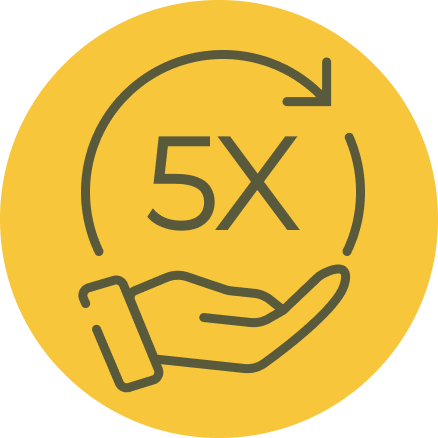Enterprise
ShapesXR
ShapesXR empowers teams to rapidly prototype, iterate, and share 3D designs in real-time, accelerating the creative process and simplifying development of immersive apps, games, and experiences.
Whether you’re a designer, developer, product owner, ShapesXR offers an intuitive, no-code solution for creating 3D designs. Anyone, regardless of experience, can start designing within minutes. From product concepts to interactive environments and XR interfaces, ShapesXR accelerates iteration and efficiency.
With real-time co-creation, teams can collaboratively build interactive prototypes, then present them to stakeholders during design reviews. Cross-platform integrations enable users to import their own 2d/3d assets directly from Figma into Shapes and export designs straight into Unity. Shapes also supports seamless sharing via the web, Unity plugin, or images, ensuring accessibility even without a VR headset.
ShapesXR provides value throughout the 3D creation lifecycle:
For Designers: Effortlessly create and prototype in 3D without needing prior experience in game engines. Test and iterate on UI design and spatial layouts directly within VR, creating interactive prototypes to validate concepts. Collaborate with developers and stakeholders, ensuring a smooth handover of design intent.
For Developers: Receive 3D handovers of design intent and user flow directly in Unity, removing guesswork from 2D images and reducing rework. Seamlessly integrate with Unity to streamline the development process.
For Product Owners and Stakeholders: Experience and review designs spatially before development begins, reducing costly iterations. Share interactive, real-scale prototypes with clients or investors to clearly communicate product vision.
Enterprise Approved
Enterprise Approved developers excel in delivering scalable results, backed by a successful track record with Global 2000 companies. Large enterprises trust this badge to find top-notch experts.
Notable Customers:
Media Gallery
Use Cases
How Simtryx Enhanced UI/UX Design of Mixed Reality Medical Training with ShapesXR
Case Study: Simtryx
Simtryx, a XR studio focused on immersive healthcare simulations, integrated ShapesXR to enhance their design process. Using ShapesXR’s prototyping tools and collaboration features, Simtryx improved their interface design workflow, ensuring accessibility and a robust user experience for the mixed reality training simulation. The tool facilitated remote team coordination and allowed efficient early testing and iteration of complex scenes in an MR environment without the involvement of developers.
Background and Objectives
Simtryx is a spatial computing startup developing the most accessible and immersive healthcare simulations for medical training in universities.
Our simulation blends the most advanced hand-tracking implementation for all kinds of physical tests, video passthrough for quick onboarding, and fully AI-powered speech interaction with the simulated patient.
Our team members are working globally, between the USA and Peru and we were looking for a tool that would allow us to redesign a more sophisticated interface without sacrificing accessibility, improve communication between the design and development team and test UX design more accurately before developing code for it.
“After experiencing the power of ShapesXR in designing our revamped user interface, it has become a staple in our workflow and a game-changer for us. Importing 3D models from our art team is seamless, and the collaboration tool encourages our remote team to work together naturally.”
– Hector Mondragon, Co-Founder & CEO
Decision Process
We’ve been using Figma for our design work with user experience and interface, but the more we built onto our product, the more we felt the need to review our design in a VR space before approving for production. This is because we found that positioning the simulation patient, with all the poses needed for user interaction, would require careful consideration when dealing with our interface and mixed reality passthrough.
ShapesXR had a clear focus on prototyping for VR apps, as there was a robust interaction system for buttons. Also, the live collaboration & sharing options were significant, and the video passthrough worked reliably. This mix of features put it right on top of our list.
Implementation and Use
ShapesXR provided powerful & intuitive VR tools to let our artists and designers arrange the interactive 3D elements in a mixed reality space. Not only did it let them test out the scenario quickly in a VR space, but also the collaboration feature heightened our team’s ability to give feedback and work better together.
Our designer would first sketch out the scenario with basic shapes from ShapesXR to represent elements that would make up the scene. Then, after a meeting inside ShapesXR with our art team, our artists would import refined 3D elements inside the prototype scene and start placing them following the designer’s mockup.
We were also able to import complex 3D models of the patient in different poses and visualize the scale and position of the patient relative to our new menus and the mixed-reality environment.
Results and Feedback
Through ShapesXR, we were able to go from our initial menu interface into our revamped and content-dense new menu. The prototyping and feedback of the new immersive menu was all done inside ShapesXR and our client shared great feedback highlighting how the new user experience is still accessible while including many more options than before.
Overall Experience
We were impressed by how easy it was to integrate ShapesXR into our current workflow.
The collaboration component works great for our remote development team and being able to design with video passthrough active is exactly what we needed for our product.
ShapesXR has become our go-to tool for our design phase and UI development. For the dozens of scenarios that we’ll be working on in our development roadmap, ShapesXR will remain a key component in our workflow.
How Treeview Implements Spatial User Interfaces for Apple Vision Pro
Case Study: Treeview
Treeview faced front-end implementation challenges while working on projects for the Apple Vision Pro and Meta Quest 3. They adopted ShapesXR to streamline their workflow, reducing implementation cycles from 5-10 to just 2 iterations. ShapesXR bridged the gap between 2D design representations and actual spatial interfaces, improving precision and collaboration.
Background and Objectives
Treeview is a high-end boutique development studio that builds AR/VR products and solutions for enterprise clients. Treeview has been working for over 8 years in the AR/VR industry and is currently ranked as the #1 AR/VR development team in LATAM.
Treeview has started developing software for the Apple Vision Pro and faced unique development challenges in the front-end implementation process for this platform.
When developing Inviewer, a Spatial STEM Simulation library, the team set out to explore an improved workflow to minimize iterations and reduce time in the front-end implementation of spatial user interfaces for the latest AR/VR technologies, including the Apple Vision Pro and Meta Quest 3.
“ShapesXR has enabled our team to drastically reduce the time for front-end implementations of Spatial User Interfaces for the latest generation of XR devices, including the Apple Vision Pro and Meta Quest 3.”
– Horacio Torrendell, Founder & CEO of Treeview
Decision Process
We were having trouble with the amount of iterations needed to get the sizing, positions, and rotations of the UI to feel correct in AVP due to the slow build cycles of Unity→Xcode→AVP. We used ShapesXR to enable the design team to define the exact spatial layout, which was then used as the source of truth for the engineering team to implement in Unity.
We use Figma as our UI design tool, but there is a large gap in communication between a 2D representation of a spatial interface and the actual spatial interface. We discovered that ShapesXR bridges this communication gap.
Implementation and Use
We used ShapesXR to design the exact spatial layout we wanted for the Mixed Reality app. We executed design reviews with all stakeholders in ShapesXR to reach agreement on the final design. Once agreed upon, this design was used as the source of truth for the front-end implementation on the Apple Vision Pro and Meta Quest 3.
Results and Feedback
ShapesXR allowed us to drastically reduce the time of implementation by reducing the amount of front-end implementation cycles. Before using ShapesXR, a front-end implementation could take around 5-10 iterations, requiring the design team to collaborate with development to really nail a high-quality interface implementation. Now with ShapesXR, we’ve reduced the iterations to around only 2: a first implementation that exactly aligns to the ShapesXR source of truth and a final polish round which completes the front-end implementation.
Previously, we would use Figma as our source of truth for the user interface, which has many gaps in information regarding sizing, distance, and rotation of objects relative to the user’s starting position. Now with ShapesXR, our team can define a source of truth that aligns exactly with the expected outcome of the front-end implementation.
Overall Experience
We started with a self-onboarding process for ShapesXR, through which we discovered the power of this tool. We then had a team onboarding session with one of the ShapesXR team members, which was invaluable for providing an in-depth presentation and offering our team a chance to ask questions and explore how we could fully leverage the tool.
One feature we found particularly useful was the layer feature, which enables us to simulate UI logic flow and even define UI animations. This is advantageous because it allows us to add more layers of detail during the design phase, ensuring all details are defined before starting front-end implementation.
Future Plans
Our plan is to start integrating ShapesXR into the design process of the AR/VR software that we build at Treeview. Being a development studio that works with many clients and many projects, we have various design processes for new AR/VR applications. Our plan is to integrate ShapesXR into our workflow, moving from Figma to ShapesXR, then to Unity, and finally to devices such as the Apple Vision Pro, Meta Quest, MagicLeap, and Microsoft Hololens.
Recommendations
We feel that ShapesXR is becoming the primary design tool for XR development. This tool should be used in all XR development teams. For us, the key benefit is that it allows the design team to cover a more extensive range of design details that are specific to spatial user interfaces. This leaves fewer design decision gaps for the engineering team to fill during the front-end software implementation.
How Logitech Designs for the Real World in VR
Case Study: Logitech
Logitech designed the digital twin of a real world event entirely in VR using ShapesXR. The team was able to invite stakeholders and decision makers in VR during the process to evaluate the design spatially and greenlight the whole event that happened in Berlin in August 2022.
The Use Case
We were tasked with designing the digital twin for the premiere of a real-world event centered around gaming in just 3 weeks. This concept had to be used to provide a clear understanding to our partners and potential sponsors of the final outcome as well as being used as a base for costing the setup of the physical venue. We started by creating some mood-boards to solidify the general look and feel of the space and created some 2D sketches to have an initial idea of the general layout and key points of interests. Right after we jumped in ShapesXR and leveraged the powerful creative tool set and the ability to import 3D models and images in a virtual environment. Thanks to the powerful and versatile snapping and alignment systems the assets could be easily assembled into complex scenes and we could create different layouts based on various sponsor options. Throughout the process we conducted several design reviews with stakeholders in VR to evaluate the whole design spatially. We were also able to directly export the project directly into Unity to create images with a higher visual fidelity that could be part of our deliverables.
“ShapesXR allows us to quickly create fully immersive scenes and populate these with key artefacts, something that traditionally has not been possible for those without the time and budget to build costly physical environments, mock ups or experience labs.”
– Andreas Connelan, Head of Design AR/VR
Value Provided by ShapesXR
Using ShapesXR as a collaborative VR creation tool, it allowed us to bridge the gaps between existing design and software workflows. All stakeholders could spatially communicate, design and iterate together in real-time using one shared tool. XR democratises 3D creation for all.
Stakeholders working side by side in the same project space as though in the same physical space promoted discussion, and allowed the spontaneity and richness of normal human interaction to occur between distributed teams. We could involve stakeholders much earlier in the concept and design processes, and get early buy-in.
Using VR, we could reduce iteration cycles by reducing ambiguity between design and production phases. Despite the extremely tight deadlines, we could produce venues explorable in VR at 1:1 scale, shareable 2D assets, and a project space detailing full project history, in one fell swoop.
Ultimately the digital twin and produced assets were presented to the decision makers helping them them to have a clear understanding of the whole event and greenlight the proposal.
About Logitech
Logitech is a global leader in personal peripherals for PC navigation, video communication, collaboration, music and smart homes. Over the past years Logitech has successfully launched peripherals on the market for VR input as well as expanded the functionalities of their existing devices to be compatible with virtual reality headsets. Logitech is going to intensify this effort and explore new opportunities for their line of products and end-to-end solutions for their customers. This requires to rethink the design and ideation process and find more effective ways to communicate and iterate rapidly on spatial ideas and concepts, to help the organization prioritize and accelerate the early design process.
Testimonials
“Reviewing MR/VR/AR designs at a 1:1 scale is vital. ShapesXR, with its in-headset multiplayer editing and Unity export plugin, has significantly revolutionized my design firmly establishing itself as a leader in XR design.”
– Yinghua Yang, Spatial Design Lead, PICO
“In VR I can whip up 10 variations of a spatial AR interface in 10 minutes without problems. ShapesXR is miles ahead of everything from flow perspective. On a desktop, you waste so much time and regressing back to 3D desktop tools is not an option for me.”
– Cody Char, Sr. UX/UI Designer, TRIPP
“The only way to really grapple with spatial design concepts such as UI positioning in 3D, contextual anchoring, and managing user attention, is to use apps like ShapesXR where you can very quickly mock this up and get an early understanding of how things look and feel spatially.”
– Daniel Robbins, Principal Designer, Adobe
“We are all stoked to have ShapesXR as a XR design tool now and it’s something that would have completely changed how we went about building our app if we have had it since the beginning of the company back in 2015.”
– Sam Hessenauer, CTO & Co-Founder, Nanome
“ShapesXR allows us to quickly create fully immersive scenes and populate these with key artifacts, something that traditionally has not been possible for those without the time and budget to build costly physical environments, mock ups or experience labs.”
– Andreas Connelan, Head of Design AR/VR, Logitech
Top Product Offerings

In ShapesXR anybody can start creating in 3D without prior experience within minutes. You can design and prototype your immersive apps, invite others to co-create in real-time, build interactive prototypes, and present them to stakeholders during design reviews. You can also share your creation with anybody without a VR headset via the Web or the Unity plugin.
Shapes equips designers, developers, and product stakeholders with the tools to bring their ideas to life effortlessly.
- Rapid 3D Design: Create and develop 3D concepts and prototypes with ease—no experience with game engines or coding required.
- Figma Plugin: Batch-import Figma UI into XR spaces to visualize and interact with designs in VR and MR.
- Unity Integration: Import ShapesXR environments into Unity, preserving structure and easily replacing assets with custom or Unity store models.
- Real-Scale Environment Design: Build true-to-scale immersive spaces for training simulations, games, or enterprise applications.
- Storyboarding & Interactivity: Design user flows, interactions, and complex scenarios with advanced storyboarding tools and versatile interactivity features.
- Collaboration: Invite team members to co-create, validate, present and share immersive designs in real-time.
Additional Details
ArborXR Demo Available: No
Trial Period Offered: Yes
Regions Supported: North America, South America, APAC, EMEA, LATAM
Notable Milestones / Awards:
- “Best Collaboration Tool” Auggie Award, Augmented World Expo 2021
- “ShapesXR Revolutionizes XR Development” – Forbes
- SOC 2 Type II

Type of Developer: AR, Authoring Tools, VR
Type of Content: Off-the-Shelf
Device Support: Oculus / Meta, PICO, Magic Leap
Industries: Automotive, EDU (Higher-Ed), EDU (K-12), Healthcare / Medical, Safety, Soft Skills
Established: 2019
Headquarters: USA
Access All Demos Now
Access demo apps from top enterprise and education developers for free.



